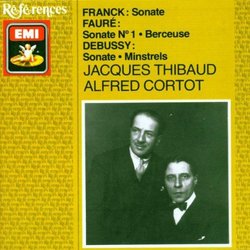Classics, beyond the wailing portamentos
Discophage | France | 04/27/2008
(4 out of 5 stars)
"The problem with the "classics" - and these Thibaud-Cortot recordings of French compositions have been recognized as such ever since their publication in 1927 (Fauré) and 1929 (Debussy and Franck) - is that listeners take them for granted and don't really listen to them. The hitch is that the reasons which made them classics in their own days may have been valid when they first came out, but those readings may also have been superseded by later versions, or made irrelevant by the evolution of performers' and listeners' tastes and expectations.
There is some of that in Thibaud's way with Franck's Sonata, especially in the swooning portamentos he applies to the first movement - the music really doesn't need that wailing sentimentality, and it is hard to conceive that the public demanded it, 70 years ago. Definitely of its time (no tape splices back then) are also Thibaud's occasional finger slips, particularly in the finale. Also, as captured by the recording process, he doesn't have very much to deliver by way of crescendo and forte - his "con tutta forza" at 4:25 in that first movement is for the salon. But Cortot's approach to Franck's elusive "Allegretto ben Moderato" tempo indication, with lazy and dreamy phrasings and gentle touch is quite convincing here, although I can imagine more animated approaches. The same is true in the finale, of which they take a gentle and tender view, which doesn't exclude moments of passion (with muscular playing from Cortot), but Thibaud's tone is a bit to thin to really sustain them (at 3:22 for instance).
On the other hand the unleashed energy and forward drive with which the two partners hurl into the second movement is irresistibly sweeping. And their precise observance of Franck's tempo transitions (poco piu lento, quasi lento, tempo I) is also what makes them, still today, deserve their status of a classic: these are perfectly judged, neither too much nor too little, "ni trop, ni trop peu" - meaning rather minimal by today's standards, but everything flows very naturally. Surprisingly, their "Recitativo-Fantasia" has little of the old-fashioned stylistic mannerisms so striking in the two first movements.
The same comments may apply to their Fauré First Sonata from two years earlier: the portamentos are there, but Thibaud and Cortot also have all the passionate Romantic sweep and convey the underlying current of turbulence. The link to Schumann is more obvious than ever. Added to the wails, the tone of Thibaud's violin in the second movement is somewhat nasal and wanting in luminosity; I wonder if it s because he is using gut strings. He also lacks a drop of power in the climaxes. But the scherzo is deliciously nimble-footed and swift-moving, a worthy pendent to Mendelssohn's evocation of the will o' the wisps, and the finale has irresistible Schumanesque passion.
More of those wailing portamentos in Debussy (not as glaring as in Franck and Fauré though), a certain lack of dynamic shading from Thibaud in the second movement and a few more occasional slips (the two performers don't finish together at the end of the first movement), but also close observance of the composer's metronome marks and tempo indications, resulting in a forward-moving skittishness that certainly represents the authenticity of the Debussy's intentions. It is a unique testimony of an interpretive approach to music that, at the time of recording, was still "contemporary" (the Sonata had been completed 12 years earlier) and from performers that had a direct link to the composer.
EMI has done a good job with the transfers: good instrumental definition and reduced surface noise. Only at the beginning of the finale of Debussy's Sonata did their source suffer annoying deterioration during circa 25 seconds, and overall the surfaces of Fauré (recorded in 1927, two years earlier than Franck and Debussy) are noisier - but the noisiest of all is the 1944 recording of the Lullaby from Dolly (last track).
"

